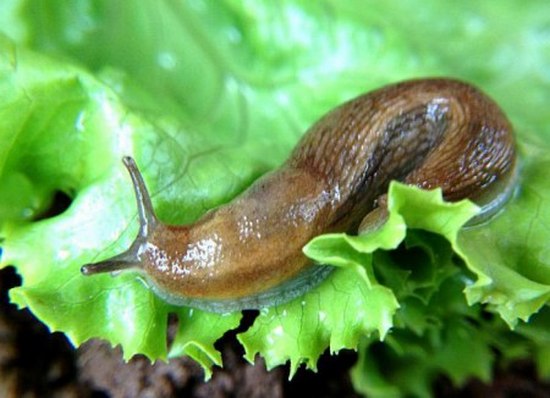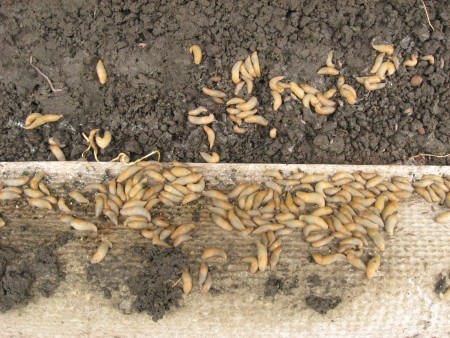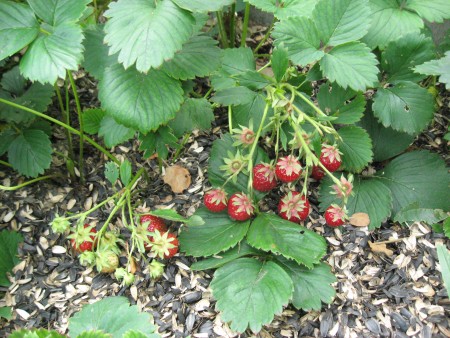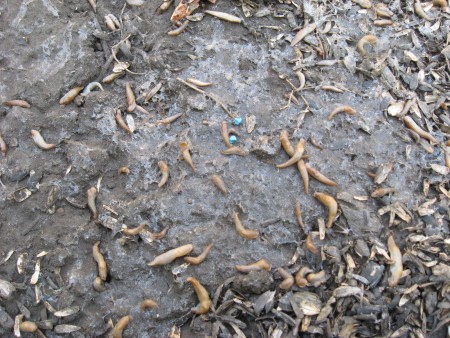I have been trying to get rid of slugs on my property for several years now. I cannot boast that the fight against these mollusks was particularly successful. but I have gained considerable experience. In any case, I can tell you which methods of killing slugs are effective and which are completely useless.
|
To successfully combat these pests, you need to know what they love and what is harmful to them. |
Slugs, despite their external amorphousness, are able to deal with rather rough food: they have jaws with a sharp edge and a thick grater tongue. Slugs are polyphagous pests, meaning they can feed on many plants. But when there is a choice, they prefer lettuce, cabbage (primarily Chinese cabbage), and strawberries to everyone else.
Thanks to the delicate organs of taste and smell, they unmistakably find their favorite delicacies. Onions, garlic, sorrel, parsley and other spicy-tasting plants are of little interest to slugs.
Let's start the fight against slugs
Completely getting rid of slugs on your property is a hopeless matter. You can fill the entire garden with Thunderstorm and Slug Eater granules, thereby violating the ecological cleanliness of the area, and the next year you will again see the slippery robbers in the cabbage or strawberry patch.
Focusing on smells, slugs are able to cover considerable distances and crawl from neighboring areas or from the nearby forest. The number of slugs can be reduced to a safe level if you know their vulnerabilities and behavioral characteristics...
Just look at these slippery creatures to understand that they are almost entirely made of water. And they need moist conditions to survive. Once in the sun, they try to hide as quickly as possible, and if they fail, soon there won’t even be a wet spot left.
For the same reason, heat is detrimental to slugs: at temperatures above 25 degrees they die. This is why pests are only active at night, when the air is humid and cool. During the day they can only be seen in rainy weather. Dense thickets of plants, which are cool during the day, are comfortable for them.
Frost is also contraindicated for slugs. Adults die already at a temperature of -3 -4 degrees.Eggs can withstand temperatures as low as -11 degrees. As a rule, adult slugs do not survive the winter, and in the spring the population begins to revive from eggs laid in the fall.
Probably, summer residents noticed that after snowless, frosty winters, and if the summer is dry and hot, there are few pests. Conversely, mild winters and occasional rains in summer help slugs to breed, which is what happened last season.
In such years, the second generation of slugs has time to hatch. It is for this reason that this fall one could see not only “fattened” mollusks, but also small things.
Let us conclude: a large number of slugs at the end of the current season does not mean that next year there will be even more pests: winter can sharply reduce their number. Especially if we help her with this.
Late in the fall, before the snow falls, we will walk around the area with a rake or flat cutter, paying special attention to those areas where there were especially many slugs. Having stirred up the top layer of soil, we will turn out the laid heaps of light translucent eggs with a diameter of about a millimeter. Of course, not all, but at least some of them. Once on the surface, the eggs will most likely die.
We will continue the fight in the spring.
- Try not to create shady, damp corners for slugs.
- It is better to water in the morning so that the soil dries out by evening.
- Do not plant or sow too thickly.
- The soil in the beds where cabbage and lettuce, loved by mollusks, grow, should be mulched not with grass, under which slugs will find shelter, but with compost, humus, sprinkled with crushed eggshells, mustard powder, and wood ash.
- Vegetable beds can be framed with plants containing essential oils: sage, mint, oregano, basil, pelargonium.
- You can do the opposite and plant lettuce seedlings next to the cabbage: its delicate leaves are more attractive to slugs than cabbage leaves. By distracting the pests, the salad will protect the cabbage. Without waiting for the lettuce to throw out flower shoots (slugs lose love for such lettuce), we will pull it out and destroy the pests hiding in the rosettes.
We will try to maintain the site clean of weeds, plant debris, under piles of which shellfish like to hide. And believe me, this is not a routine recommendation; in cluttered areas it is simply useless to fight slugs.
A simple and effective slug trap
Instead of natural shelters, we will build traps for slugs. We will place boards, pieces of slate, damp rags, pieces of thick film folded in several layers in damp, shady places and check them every few days.
Clumps of pests can be sprayed with a hand sprayer with a solution of salt or vinegar; such a shower will quickly kill them (but it is much easier and faster to crush them with your feet)
Gastropods like to hide under plastic buckets filled with water, such as paint buckets.
To make slugs more willing to gather in shelters, the area is not watered for several days, then traps are placed around the perimeter, and the soil under them is abundantly moistened.
It is these traps that are the most effective folk remedy for killing slugs in the garden. You won’t get rid of them completely, but you can reduce the number and very noticeably. Just check the traps not 2-3 times during the summer, but regularly throughout the season, otherwise these traps will turn into excellent havens for pests.
Many ways to combat slugs are described on the Internet, but in practice they turn out to be of little use. Well, you won’t be filling your garden with salt, lime or ground pepper several times over the summer. The same can be said about spraying with solutions of ammonia, vinegar, and so on. Such treatments will have to be carried out almost every day.
I also tried placing cans of beer around the garden. In two nights, only a few pests were caught there. From this I concluded that the love of slugs for beer is greatly exaggerated or even far-fetched.
Ash, which can be sprinkled on the ground around the plants and on the plants themselves, helps a lot. The only question is where to get so much of it, since it’s forbidden to burn fires, and bathhouses are rarely heated in the summer.
How to rid a strawberry plantation of slugs
The bodies of gastropods are very delicate and they try not to crawl where they could get hurt by some prickly or sharp objects. Knowing this, some gardeners try to protect their beds with pine needles.
I tried this option too. I filled the rows of strawberries with pine needles and the pests actually decreased. Unfortunately, this method has a side effect. The needles strongly acidify the soil and the next year our strawberries all turned yellow.
I had to rake out all the needles and throw them away. Instead of needles, the strawberries were again covered with seed husks. The result was approximately the same. There are much fewer slugs. If previously they devoured most of the harvest, now (and this is already 4 years) most of the berries go to us.
Natural enemies of gastropods
And don’t forget that even slugs have enemies in nature: rooks, starlings, jackdaws, hedgehogs, lizards, shrews, moles, frogs, toads. Toads are especially keen on slugs.And if you move several amphibians to the site, they will rid it of slippery pests. In the fall, you can release chickens and ducks onto the plot so that they clear the beds of slugs.
Chemicals to combat shellfish
Having tried many drugs (not all of course) I settled on Slime Eater. According to my observations, this drug destroys slugs best. Below is a photo document. The spectacle is certainly disgusting, but it clearly shows the effectiveness of this poison.
If you still decide to get rid of pests with the help of chemicals, do not scatter Thunderstorm or Slug Eater granules over the surface of the rows, but place them in a cardboard rolled up into a tube. The active ingredient in pesticides is toxic, and it is safer if the granules do not come into contact with the soil.
Do not cultivate the rows of the beds where green crops grow. In other areas, treatment is stopped 20 days before harvest.
For myself, I made the following conclusions:
- “Wet” traps are most effective.
- To prevent pests from entering the beds, you need to cover them with seed husks.
- If you poison, then the Slug Eater.
I repeat once again: these measures will not get rid of slugs forever. However, like everyone else.
Watch the video about ways to fight slugs, there are some very interesting tips:
I would be glad if readers share their ways of dealing with these pests or correct me if I’m wrong about something.
You might be interested in:
- How to deal with wasps in your summer cottage
- How to get rid of ants from the garden
- Treatment of the garden from diseases and pests
- Fighting whiteflies in a greenhouse and exhaust gas





 (9 ratings, average: 4,56 out of 5)
(9 ratings, average: 4,56 out of 5) CUCUMBERS NEVER GET SICK, I'VE BEEN USING ONLY THIS FOR 40 YEARS! I SHARE A SECRET WITH YOU, CUCUMBERS ARE LIKE THE PICTURE!
CUCUMBERS NEVER GET SICK, I'VE BEEN USING ONLY THIS FOR 40 YEARS! I SHARE A SECRET WITH YOU, CUCUMBERS ARE LIKE THE PICTURE! You can dig a bucket of potatoes from each bush. Do you think these are fairy tales? Watch the video
You can dig a bucket of potatoes from each bush. Do you think these are fairy tales? Watch the video
 How our fellow gardeners work in Korea. There is a lot to learn and just fun to watch.
How our fellow gardeners work in Korea. There is a lot to learn and just fun to watch. Eye trainer. The author claims that with daily viewing, vision is restored. They don't charge money for views.
Eye trainer. The author claims that with daily viewing, vision is restored. They don't charge money for views. A 3-ingredient cake recipe in 30 minutes is better than Napoleon. Simple and very tasty.
A 3-ingredient cake recipe in 30 minutes is better than Napoleon. Simple and very tasty. Therapeutic exercises for cervical osteochondrosis. A complete set of exercises.
Therapeutic exercises for cervical osteochondrosis. A complete set of exercises. Which indoor plants match your zodiac sign?
Which indoor plants match your zodiac sign? What about them? Excursion to German dachas.
What about them? Excursion to German dachas.
No matter what I tried, the most effective were simple traps - boards or cabbage leaves. In the morning you just need to collect the “harvest” of slugs
I apologize, but you have an error when commenting - “Comment awaiting approval”
Thank you, Sergey. Corrected.
Yes, I also have a significant “harvest” of slugs this year! I noticed that slugs really like raw meat. They climbed into the dog's bowl, even the licked one (I added raw beef to the dog's food) in a large crowd. I then flushed them down the drain. Several times during the evening I caught these nasty reptiles in different places in the yard. Well, under plastic buckets, slate, even under zucchini leaves. They "run" very quickly. Once I left a bowl of slugs for a few minutes, and when I returned, I saw that they were nowhere to be found! Escaped! Yes. collect, collect and collect! But you give up when you think that no matter how much you collect, they will creep in from your neighbors, but not in larger numbers!